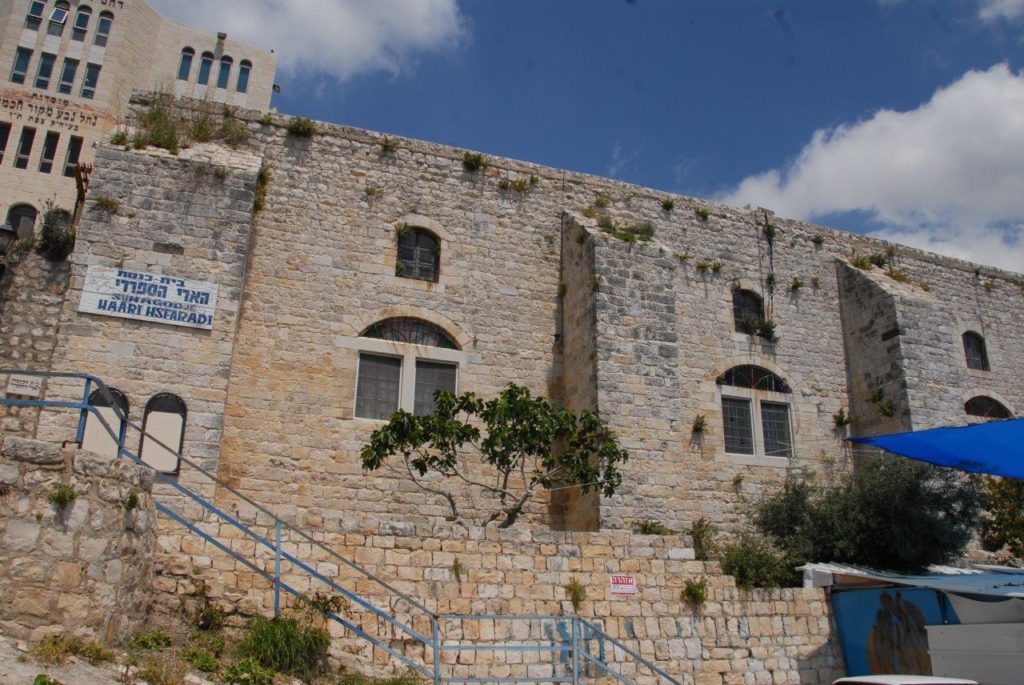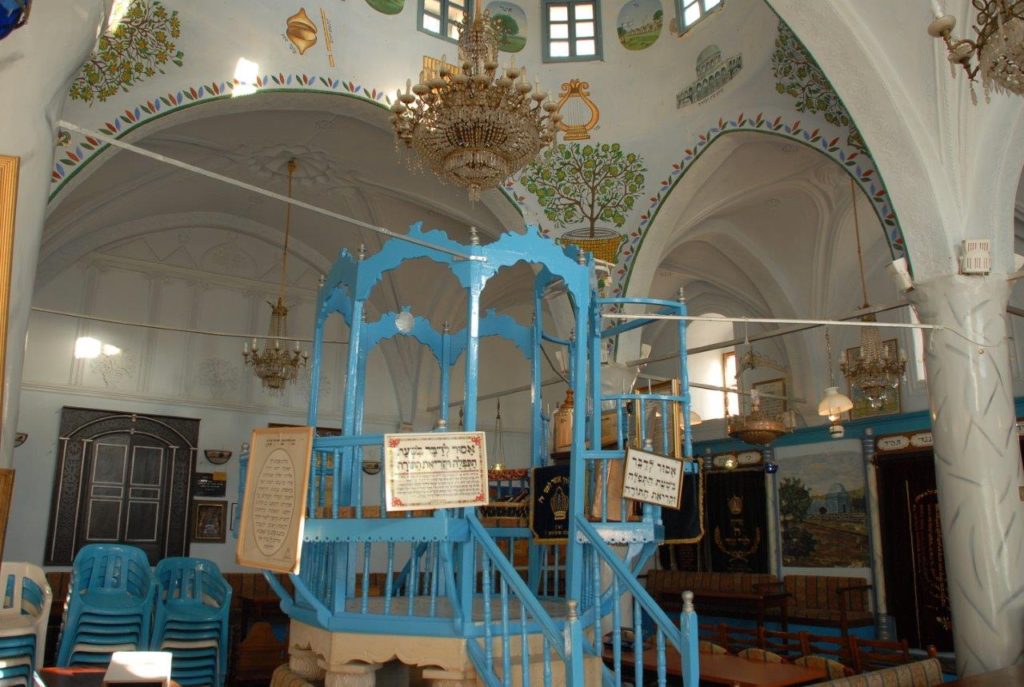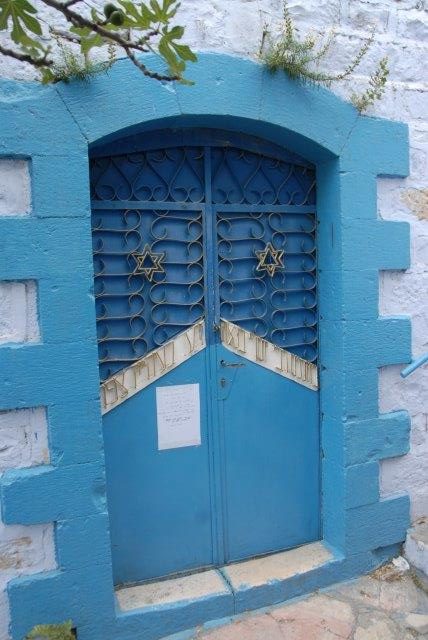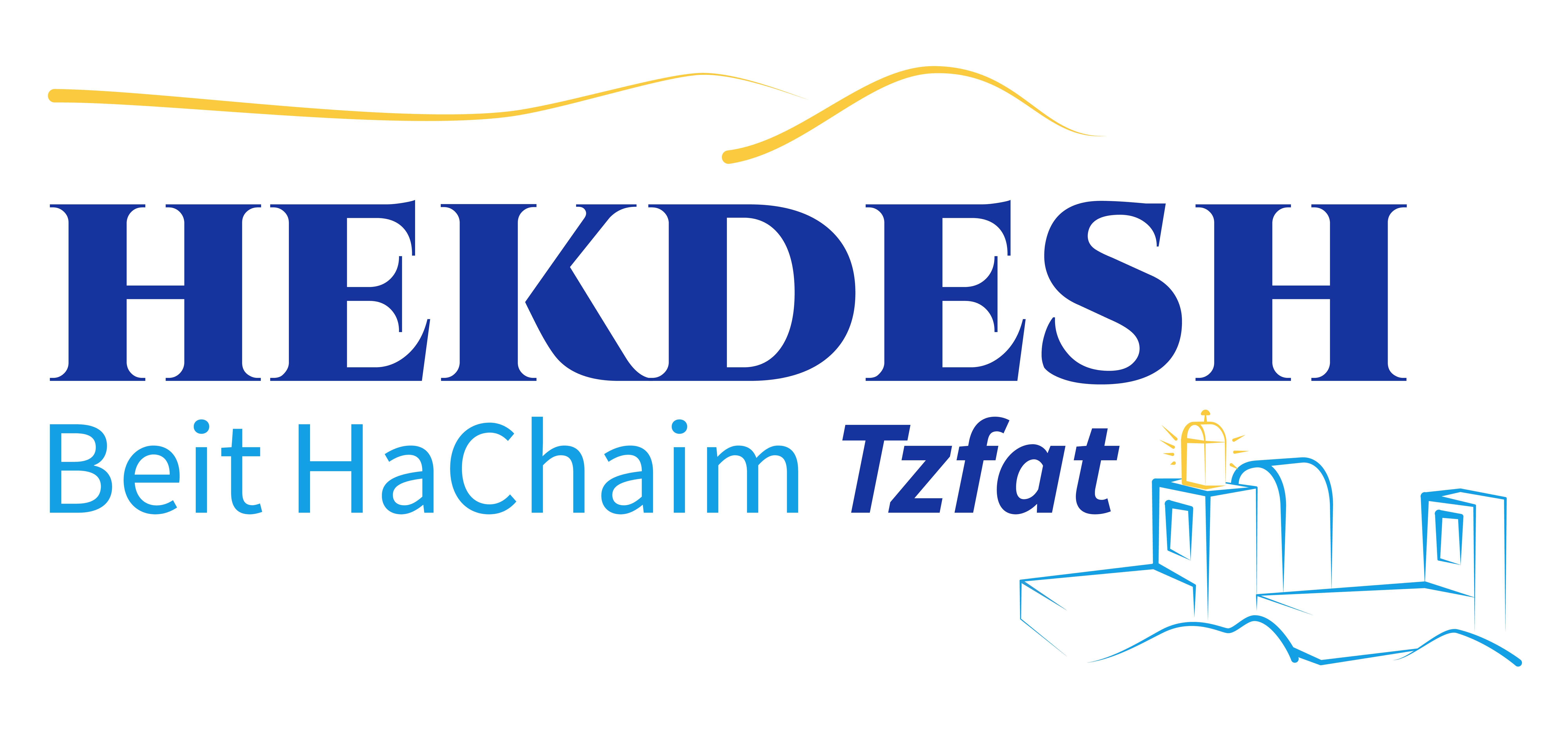THE ANCIENT SYNAGOGUES

The “Ari Sephardi” Synagogue
According to tradition, it was here that the Holy Ari (Rabbi Yitzchak Luria, of blessed memory) learned Torah. In the cave that opens up from the synagogue’s eastern wall, the Prophet Eliyahu revealed himself to him and transmitted “revelations” and explanations to him in the esoteric and kabbalistic teachings. This is the oldest synagogue in Tzfat; a most unique structure in its dimensions and its magnificently adorned ceiling. The great earthquake of 1837 destroyed most of the synagogue and it was restored through the contributions of the philanthropist, R’ Yitzchak Gueta. In 5708 (1948), it served as an important frontline post against the Arab neighborhood of Charth El Romana. Searing gunfire opened a gaping hole in the southern wall and served the defenders of Tzfat. This wall was recently renovated and restored.

The Abuhav Synagogue
This is the most magnificent of the ancient synagogues in Tzfat, exceptional for the symbols artistically drawn on its domed ceiling, borne by four wide pillars. It is named after the Sephardic sage, R’ Yitzchak Abuhav, who lived in Spain during the fifteenth century, and his students, among them R’ Yaakov Beirav, emigrated to Tzfat. Preserved in one of the synagogue’s three sacred arks for the Torah scrolls is his ancient and holy work “Sefer Abuhav”, known for its concealed spiritual strengths. The elders of Tzfat believe that in the merit in his tremendous holiness, the southern wall of the structure survived the great earthquake of 1837, and the holy arks sustained no damage. As a means of securing G-d’s blessings for fertility and family purity, many Tzfat residents have been accustomed for many years to holding wedding ceremonies in the synagogue’s courtyard. Recently, there has been construction work to renovate and restore the structure.

The Yosef Caro Synagogue
Located on “Beit Yosef” Lane, this synagogue is named after the compiler of the Shulchan Aruch (Code of Jewish Law). The original structure was destroyed during the earthquakes that struck Tzfat in 1759 and 1837. Above the entrance, there is an engraved stone commemorating the recent restoration projects. According to tradition, the “Maggid” revealed himself to Rabbi Yosef Caro in the basement built under the synagogue, helping him in the composition of his important texts. Miracles and wonders are connected with this basement, with sixteenth-century accounts retelling how voices were heard from its walls during the nights.

The “Ari Ashkenazi” Synagogue
Located in the heart of the Jewish Quarter of Tzfat’s Old City, this synagogue is named after Rabbi Yitzchak Luria, considered the greatest of the Tzfat kabbalists from the sixteenth century, and the father of the new kabbalistic teachings that merited the title “the Lurianic kabbala”. The “Ari” was born in Jerusalem in 1534 to an Ashkenazic father and a Sephardic mother. He spent most of his life in Egypt with his uncle, R’ Mordechai Francis, who was in charge of the Egyptian customs house. In a letter found in the Cairo archives, it was discovered that apart from his kabbalistic studies, the Ari also was involved in the spice trade. In 1570, the Ari arrived in the Holy City of Tzfat, where a number of disciples began to gather around him who came to be called “Gurei HaAri”. Two years later, in 1572, at the age of only thirty-eight, the Ari passed away and was buried in the ancient Tzfat cemetery.
In the past, it was assumed that the synagogue was situated outside the ancient Jewish quarter in a place called “Sde Tapuchim”, where the Ari customarily greeted the Shabbos together with his students. According to tradition, it was only after his passing that his disciples built the synagogue on that plot of land. However, it was recently discovered that the synagogue was built some fifty years earlier by immigrants from Spain during the first half of the sixteenth century. These immigrants had first settled in Greece (after their expulsion from Spain in 1492), and then several years after the Ottoman armies conquered Eretz Yisrael in 1517, they emigrated to the Holy Land and settled in Tzfat, some time prior to the Ari’s arrival in the city, and established this synagogue, which was originally called “Gregos” (Greek). It was only in the eighteenth century, after the chassidic emigration from Eastern Europe, that the name was changed to the “Ari Ashkenazi” Synagogue. As with many houses in Tzfat, the entrance to the synagogue points westward, in the direction of the tomb of Rabbi Shimon bar Yochai. The pillar served as a beacon, which was customarily lit on Lag Ba’Omer for the Rashbi’s hilula. In the past, elderly and infirmed people who were unable to participate in the Lag Ba’Omer celebrations on Mt. Meron would surround the synagogue beacon for the traditional lighting, designated “Hadlakat Zuta”. In 1837, the synagogue was seriously damaged by the great earthquake that struck the city of Tzfat. The synagogue was re-dedicated only about twenty years later, as is shown by the inscription of the face of the structure, dated 1857. This synagogue stands to this very day, serving a community of regular worshippers, visitors, and holiday tourists.

The “Tzaddik HaLavan” Synagogue
In the old Jewish quarter of Tzfat, there is the synagogue of Rabbi Yosi Bannai (“HaTzaddik HaLavan”). This synagogue contains an ancient Torah scroll and the traditional tomb of Rabbi Yosi. Among his sayings: “One who practices Torah for its own sake, his Torah becomes a potion of life for him; and one who practices Torah not for its own sake, his Torah becomes a potion of death for him.” In the synagogue’s courtyard, there is the branch of an ancient fig tree, regarding which the city’s elders tell an interesting legend: Rabbi Yosi Bannai would repair the ruins of Tzfat and Jerusalem, employing workers for that purpose. Once during the winter, he was involved with the repair of a synagogue in Jerusalem, and he left his son back in Tzfat. That same day, the workers were gripped by hunger and asked for something to eat. The son didn’t know what to do, since he had no food and no money to buy any. In his state of distress, he went to the fig tree and recited the oath that he had learned from his father: “Fig tree! Fig tree! Produce your fruits and feed Father’s workers!” The fig tree ripened and grew its fruits, and the starving workers ate until they had satisfied their hunger.
The next day, Rabbi Yosi returned to Tzfat and his son told him about the miracle with the fig tree. Rabbi Yosi sighed bitterly and said, “My son, you troubled Alm-ghty G-d to produce fruit from the fig tree not in its proper time, and therefore, you will be taken not in your proper time.” The very next day, the son passed away.
During the days of the Turkish rule, Tzfat had a most cruel governor who would cause tremendous suffering to the local Jewish community, harassing them at every opportunity, especially when it came to spoiling their holiday joy. When this wicked ruler learned that the Jews customarily buy white chickens for “Kapparos” on Erev Yom Kippur, he ordered the Jews of Tzfat to use only black chickens, and anyone who violated this order would be hanged.
The residents of Tzfat were very upset and frightened, but left with no alternative, they went to the marketplace and bought black chickens in the presence of the governor’s messengers. After consulting with the city’s rabbi, they all went to visit the gravesite of Rabbi Yosi Bannai. With tears of supplication, they pleaded from the tzaddik that he should be their defender before the Heavenly Court, so that they shouldn’t be forced to do Kapparos on black chickens. The tzaddik responded to their pleas, and decided to break the evil decree. When the Jews returned home, they found that all the chickens had turned as white as snow. The miracle brought great joy to the Jews of Tzfat, and ever since, Rabbi Yosi has been called “HaTzaddik HaLavan” (the white tzaddik).

